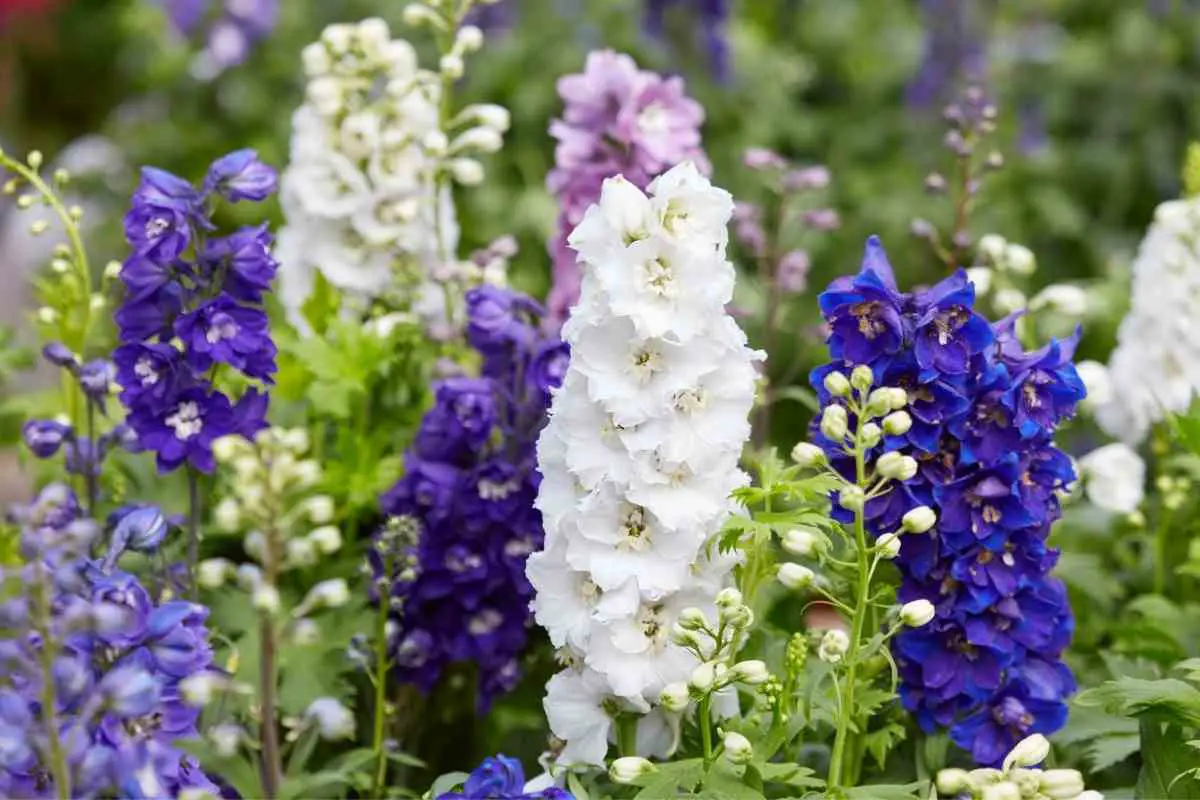Delphiniums deliver a riot of colour, well in keeping with the glorious English summer!
It is well worth the hard work of growing them to see the vivid spikes they produce in June and July, perfect for pollinators.
If you would like to enjoy the sapphire blue, red, pink and mauve shades of classic Delphiniums this comprehensive growing guide will equip you with the knowledge to make a success of these classy perennials.
All About Delphiniums
The Delphinium genus is part of the buttercup (Ranunculaceae) family of plants and spans over 300 species of flowing perennials.
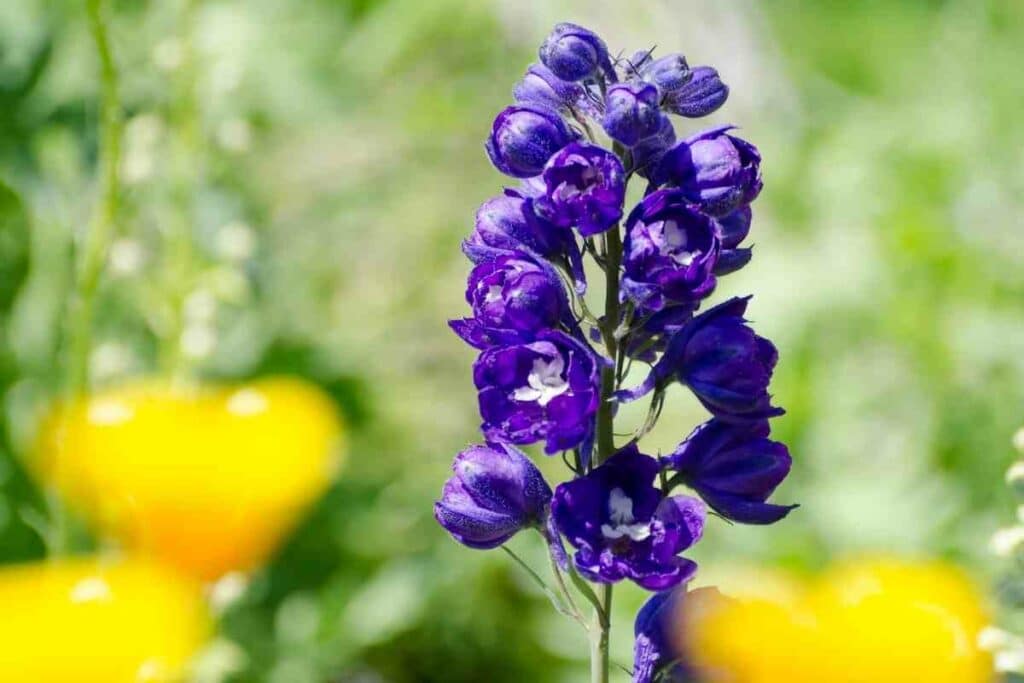
The word “Delphinium” sounds like dolphin and is derived from the Greek delphinos, probably because of the shape of their flowers.
Delphiniums are distributed across the Northern Hemisphere and have been cultivated in the UK for centuries, where they go by their Tudor name, Larkspur.
Delphinium Description
Like hollyhocks or foxgloves, delphiniums produce tall spikes of inflorescence with single or double flowers that are most often a vivid blue.
Varieties (which we share below) vary by flower colour, the height of the plants and the numbers of flowers each plant produces.
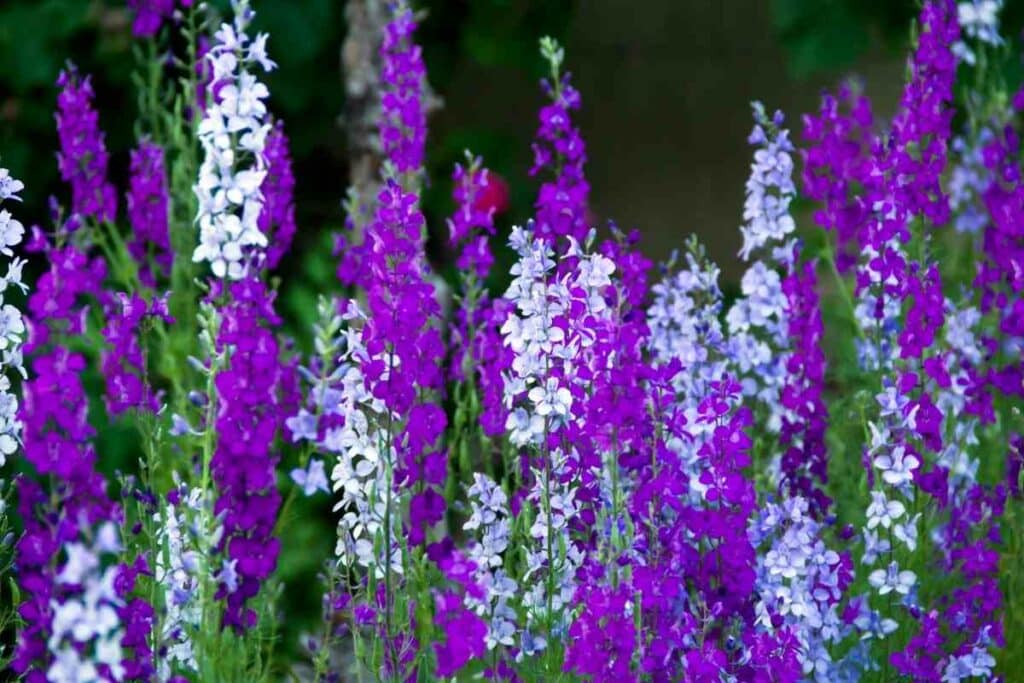
Delphiniums can not only be perennials but also annuals and biennials.
The tallest variety, the Elatum group can reach two metres in height.
Other varieties like “Belladonna” are shorter, with a more branched structure and individualised flowers.
The Delphinium Flower and Foliage
Gardeners appreciate delphiniums for their tall upright stems with palmate and deeply lobed leaves.
The summer months see Delphiniums bring forth a dramatic raceme of bilaterally symmetrical flowers with multiple stamens.
The flowers have five petal-like sepals that form a hollow pocket with a spur at the end, with four true petals inside.
The long upper spur encloses nectar-containing spurs of the upper petals which attract butterflies and bees.
Following pollination, the plant produces small, tiny black seeds.
Delphinium Toxicity
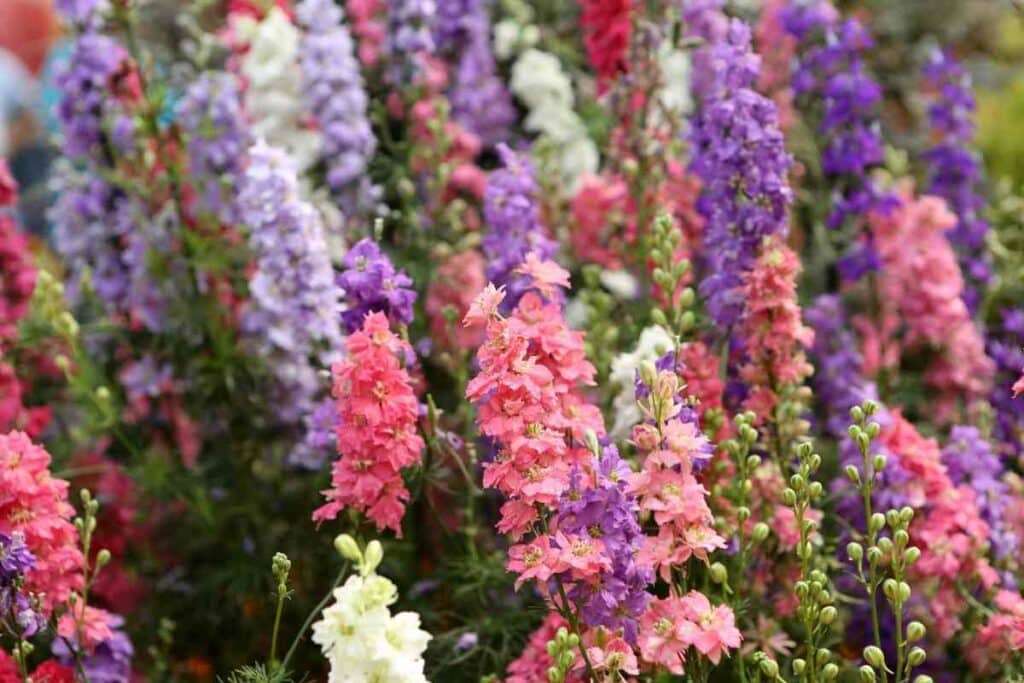
Delphinium is toxic to humans and livestock, though some species of moths and butterflies can eat this plant without harm.
Perfect for the English Country Garden
Delphiniums are a lovely choice of plant for herbaceous borders and give gardens that classic cottage garden.
They are well worth including if you are planning for year-round colour and are hardy perennial plants that look delightful as cut flowers in a vase.
They look beautiful with:
- English roses
- Lupins
- Foxgloves
- Stocks
- Peonies
- Verbascum
How to Grow Delphiniums
The best time of year to plant delphiniums is in autumn or spring when the soil is warmer, though you can plant them throughout the year.
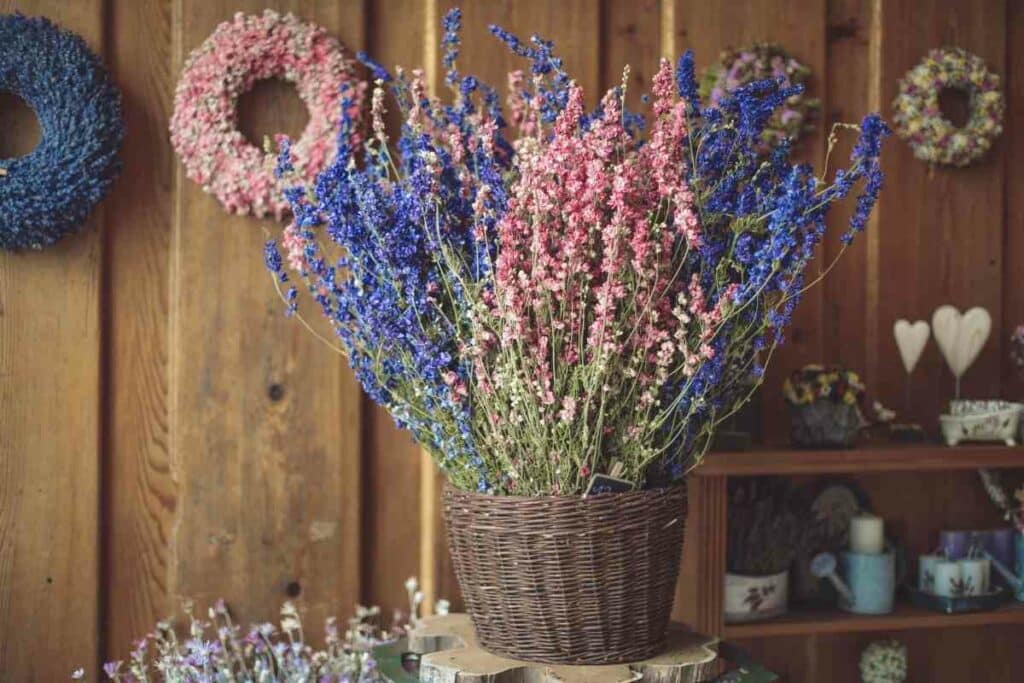
Delphiniums thrive in soil that is well-drained and moist. Prepare your soil by adding a handful of grit to the planting hole when you are planting them.
This will help the Delphiniums survive the winter when the soil becomes waterlogged.
Remove delphiniums from the pot and plant them at a similar depth adding a rich manure feed. Back-fill with soil and water in.
You will need to provide them with full sun so look for a position away from the shade.
If you are planting them along a border they can be towards the back as they are taller than other plants.
Avoid windy positions as these tall stems can be blown over. Most gardeners use one stake per stem which runs from the base of the plant to just beneath the flower heads.
You need to protect young shoots from slugs as they emerge until the plant gains height. Delphinium experts Blackmore & Langdon use a potent garlic drench to deter slugs.
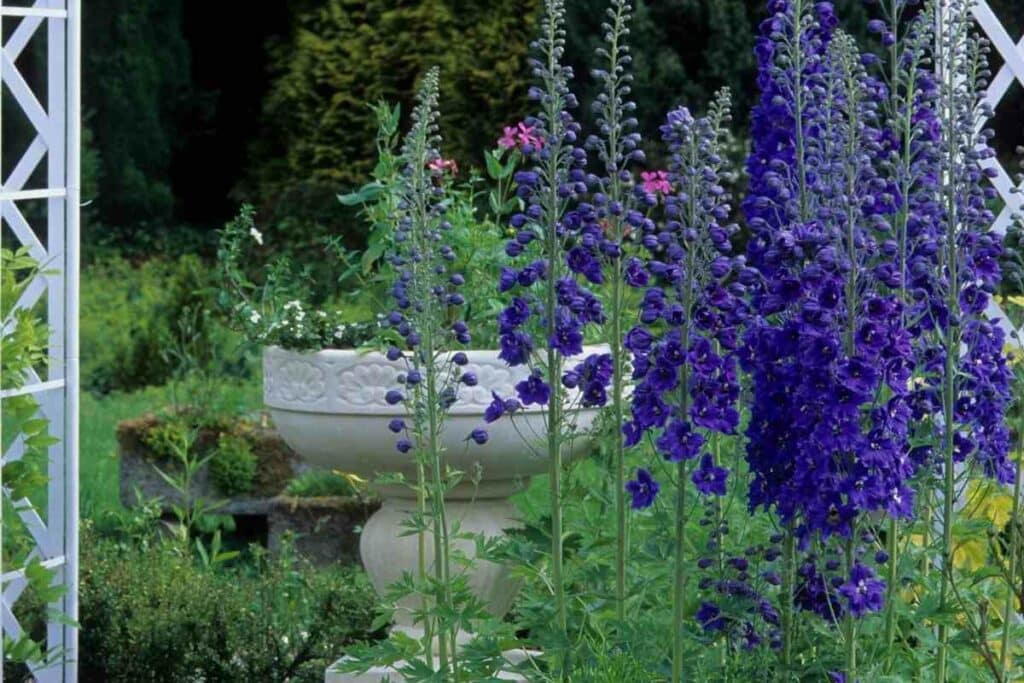
Make your own by steeping garlic cloves in hot water. Cool and strain the liquid and add to a spray bottle to douse your young delphiniums.
The young plants will need to be staked. Do this in the early spring as they begin to grow. Staking is important as the wind, storms or even heavy summer rains can snap the stems.
The tall stems also need support as the blooms can become heavy with dew and rainwater.
You can use canes to stake taller delphinium varieties or erect frames that plants can grow up through.
Watch this video to see how to tie in your delphiniums to a stake or frame.
Feed your delphiniums with a high potash fertiliser.
All that growth and flowering makes delphiniums very hungry plants. During the summer months, they should be fed at least twice with a good slow-release fertiliser
Seaweed fertiliser is another effective option.
The flowering season of Delphiniums is vivid but short.
If you cut back the stems of your delphinium back after their first flowering, you can enjoy a second flowering in late August through early September.
This should be done as soon as your first blooms start to fade.
Take a look at how experienced gardeners prune delphiniums after flowering
At the end of the flowering season, cut your Delphiniums right back!
Cut back your delphinium right down to the soil when the flower spikes become tatty for the final time.
Leave any developing side shoots.
You can water and feed the plant ahead of the winter.
Growing Delphiniums from Seed
You can successfully sow and grow delphinium seeds of any varieties you want.
You can also save seeds from existing delphinium plants.
Growing from seed requires more time and care but can be cheaper than buying plants from a nursery.
Delphinium seeds can be sown from February to June, or later in the year in September or October.
Follow this process:
- Start your seed in a seed tray with warm, moist potting compost.
- Delphinium seeds require a cold start so should be refrigerated before planting.
- Cover your seeds with a light covering of soil.
- The seedlings should be kept in a dark place at a temperature of 50°-60°F.
- Pot on your delphinium cuttings when they become established so they keep on growing strongly.
- Use nutrient-rich compost to promote the best growth.
In warm weather (late spring/early summer) you can sow the seeds directly outside.
Germinate them first by placing them on a moist paper towel or coffee filter paper.
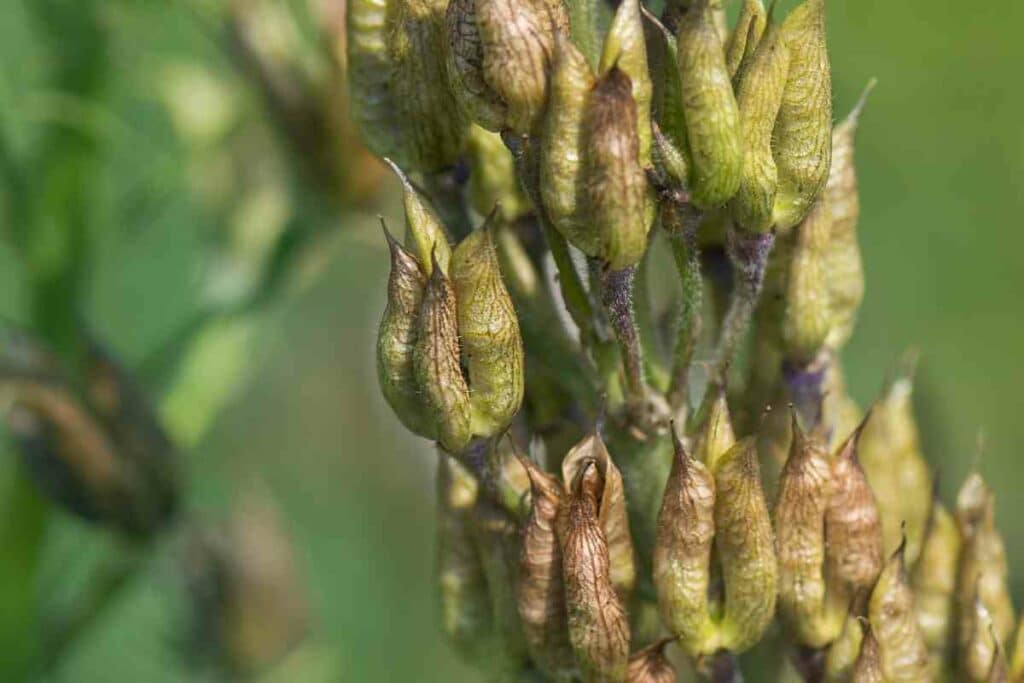
Propagating Delphiniums
Delphiniums can be propagated from basal cuttings (from the base of the plant).
This should be done when the plant starts to grow in the spring.
Here’s How to Take a Basal Cutting from a Delphinium
Here is the process:
- When you see new shoots appear on a plant, you can cut individual shoots with a sharp clean knife at a level just below the soil surface.
- Take no more than two shoots from each plant and place them in a plastic bag to keep them moist.
- Cuttings should be prepared by cutting off excess foliage, leaving one or two leaves in place to feed the developing roots.
- You can pot up your cutting in good multipurpose compost.
- Water the cutting and cover the pot with a plastic bag, misting the developing plant regularly to stop it from drying out.
- Place in a sunny spot until it is ready to plant outside.
Frequently Asked Questions for Growing Delphiniums
Can Delphiniums Cope with High Temperatures?
Though delphiniums appreciate the sun, they do fare better in cooler temperatures.
On hot summer days, prevent the flowering plants from drying out by keeping the soil slightly moist at all times.
What are the Main Pests to Look Out for When Growing Delphiniums?
The young springtime growth of delphinium shoots is a target for several pests, which can continue through to the summer months.

You will need to take action to protect them or the shoot will be destroyed or more mature stalks and flowers will be susceptible to disease.
Delphinium pests include:
- Slugs and snails: these gastropods will target tender new growth and leave ragged holes in leaves. They are repelled by a liberal garlic drench or trapping with beer.
- Aphids: Aphids and other sapsuckers can gather on the undersides of delphinium leaves or around buds. Their feeding has the effect of stunting growth and turning the leaves yellow and brown and distorting them. Treat affected plants with fatty acids, neem oil and other insecticidal sprays
- Cyclamen mites: these tiny mites produce black spots on the delphiniums leaves and stems. They are also sapsuckers. Insecticidal soap sprays can be helpful in controlling these insects.
- Nematodes: certain nematode species can cause root damage, producing yellowed, stunted plants. This problem can be managed by feeding the soil to promote beneficial fungi that kill the nematodes.
- Leafminers: these insect larvae feed on the leaves, causing discolouration, blight and collapse, a soap spray treatment may help to eradicate them.
What are Delphinium Diseases to Look Out for?
Delphiniums are susceptible to several common plant diseases including:
- Powdery mildew can be brought out in dry weather. Keeping the soil around your delphiniums moist can help while ensuring the foliage is dry.
- Rust produces rust-coloured pustules on the foliage of the delphinium. Rust can be prevented by picking off affected leaves and removing dead foliage in the autumn.
- Delphinium black blotch is a bacterial disease that produces large black blotches on the foliage. It is more likely to occur during wet summers and can overwhelm a plant. The best management is to remove affected parts of the plants with secateurs to prevent the spread of this disease.
What Should I Look Out for When Buying Delphiniums?
Buying a young plant from a reputable nursery or online retailer is a quick and easy way to have the beautiful blooms of the delphinium in your garden in time for summer.
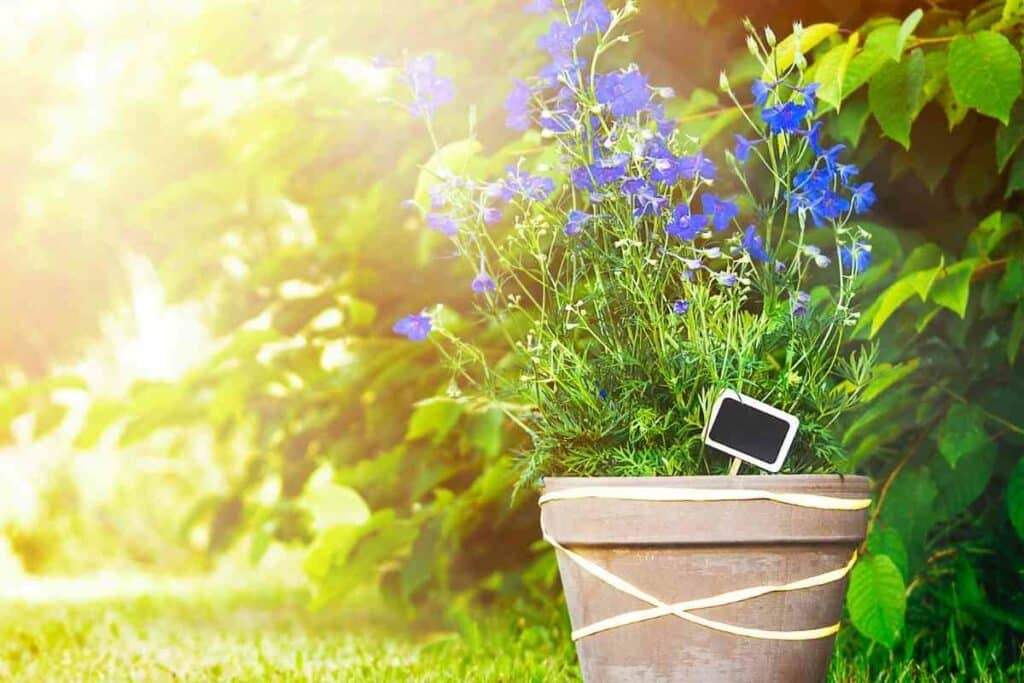
Also, ensure that you choose a variety that grows to a height that is manageable for you as delphiniums can become large, tall plants.
If you can examine the specimens before you buy them, look for the quality ad health of the foliages and check for signs of the common pests and diseases.
What are the Best Delphinium Varieties to Grow?
Planting a selection of the popular varieties of delphiniums will make a great display in your garden.
Here are some of the leading varieties.
Delphinium ‘Amadeus’
Delphinium ‘Amadeus’ is a classic delphinium cultivar that is acclaimed for its rich blue/ violet flowers with velvety petals that have a dark brown ‘eye’. Amadeus achieves a maximum height of just over 1.5 metres and a spread of 1 metre.
Delphinium ‘Pacific Hybrids’
Pacific hybrids is a dramatic variety with dense single or double flower heads that come in a variety of colours.
These tall flower spikes are beautiful cut and displayed in your home in a vase. Also known as ‘Pacific Giants’ these plants grow to 1.5 metres in height with a spread of 75 centimetres.
Delphinium ‘Rising Stars Mixed’
Delphinium ‘Rising Stars Mixed’ is a best in class variety that produces slighter small and more compact plants that are ideal for smaller gardens.
This hardy perennial comes in a variety of colours including blues and pinks with different flower types.
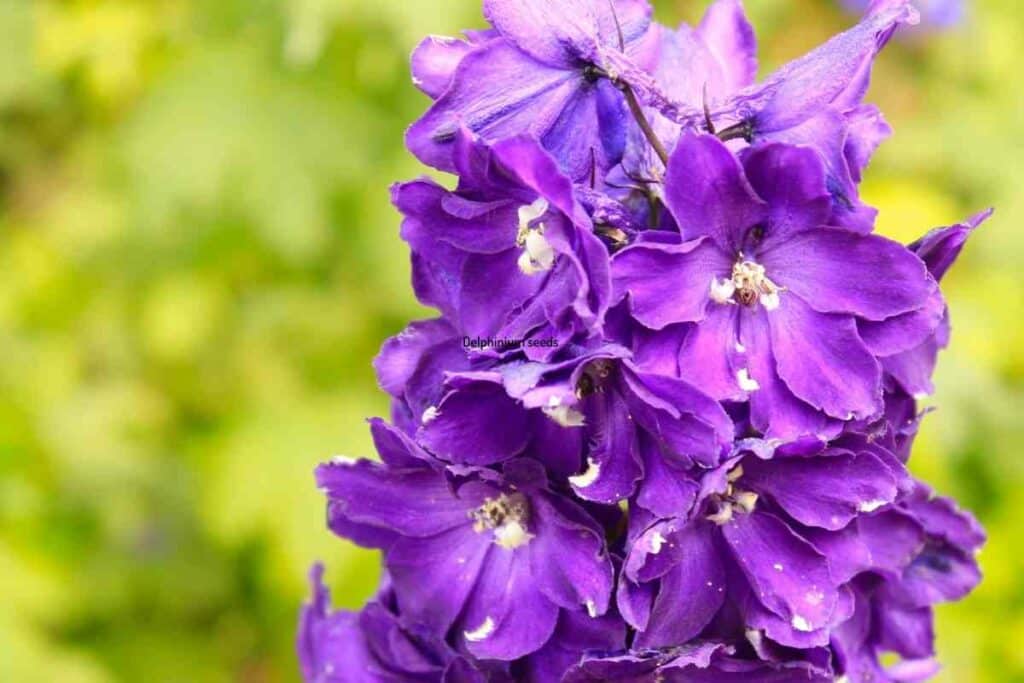
‘Rising Stars Mixed’ has a height of approximately 1.2 meters with a spread of 75 centimetres.
Delphinium ‘Magic Fountain Series’
‘Magic Fountain Series’ gives rise to compact plants that would look great in a small garden or balcony.
This colourful variety produces a height of 90 centimetres and a spread of 60 centimetres.
Delphinium elatum ‘Faust’
Bring some drama to your garden with these massive 2.5-metre flower spikes that are packed with vivid blue double flowers, with a dark centre.
Delphinium elatum ‘Cinderella’
This is a smaller pink delphinium plant that does not skimp on beauty.
It has strong stems and triple blooms. Cinderella achieves a height of 1.2 metres and a spread of 80 centimetres.
Top tip!
Keep your delphiniums flowering well by dividing them in the spring every few years.
Rounding Up
Delphiniums are quintessential English flowers that are full of character and colour.
With some targeted care throughout the year, these long-legged ladies will keep you in a riot of colour for many years to come!
